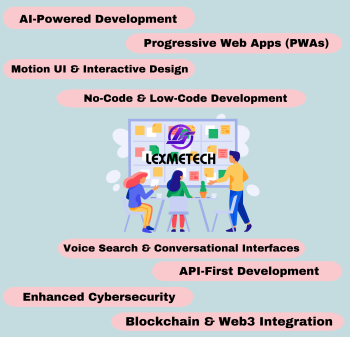In today's rapidly evolving digital landscape, mastering web developer skills has become essential for those looking to create impactful online experiences. As we step into 2024, the need for skilled developers continues to soar, making it imperative to stay ahead of the curve with a comprehensive skill set. From understanding the basics of coding to deploying sophisticated web applications, the journey to becoming a proficient web developer involves a meticulous blend of technical knowledge and practical application. This article aims to serve as your 2024 roadmap, guiding you through the essential skills and technologies that are crucial for success in this dynamic field.
The roadmap begins with an exploration of front-end development,
detailing the languages, frameworks, and tools that are key to crafting
responsive and user-friendly interfaces. It then transitions into the back-end
development segment, highlighting the server-side languages and database
management systems that power the web behind the scenes. For those aspiring to
become versatile in the full-stack web development roadmap, a comprehensive
guide on merging front-end and back-end skills is provided. Additionally, the
article covers strategies for building and deploying projects, enhancing web
developer skills through practical applications, and effectively showcasing
your work to potential employers or clients. Concluding with a summary of key
takeaways, this roadmap is designed to equip you with the knowledge and
confidence needed to excel in the world of web development.
Roadmap to Front-End Development
Front-end development is crucial for creating user-friendly, attractive websites that users find engaging and easy to navigate. This development phase focuses on the user interface and experience, utilizing core technologies like HTML, CSS, and JavaScript, which are essential for structuring, designing, and adding interactivity to websites.
Core Technologies: HTML, CSS, JavaScript
HTML (HyperText Markup Language) forms the backbone of web content, laying out the basic structure of web pages. CSS (Cascading Style Sheets) enhances this structure by providing style and design, allowing developers to create visually appealing interfaces. JavaScript brings these static pages to life, enabling dynamic interactions and functionalities. Mastery of these languages is fundamental for anyone aspiring to excel in front-end web development.
Frameworks: React, Angular, Vue
Frameworks and libraries play a pivotal role in modern front-end
development by offering structured ways to build complex applications
efficiently. React, developed by Facebook, is renowned for its
flexibility and efficiency in building interactive user interfaces. It is
particularly favored in projects requiring dynamic content updates, such as
single-page applications.
Angular, maintained by Google, offers a comprehensive
development framework with robust features like two-way data binding and
dependency injection, which streamline the development process and enhance
productivity. It is ideal for developing large-scale enterprise applications.
Vue.js, known for its simplicity and ease of integration, is
another popular choice among developers. It is particularly appealing for
projects that require a lightweight and flexible framework capable of
delivering high-performance applications with minimal overhead.
By understanding and utilizing these technologies and frameworks, developers can create responsive and efficient applications that meet the needs of modern users, ensuring a seamless web experience.
Roadmap to Back-End Development
Server-Side Languages: Python, Node.js
Back-end development is integral to web applications, focusing on server-side logic, databases, and application programming interfaces (APIs). A variety of server-side languages are employed, each with unique strengths and suited for different project needs. Python is widely recognized for its readability and versatility, often used in web applications, data analysis, and more, with frameworks like Django and Flask enhancing its capabilities for back-end development. Node.js, transforming JavaScript into a server-side technology, enables developers to use JavaScript for both front-end and back-end development, making it ideal for projects that require real-time capabilities and scalable web services.
Database Management
Effective database management is crucial for back-end development,
involving the creation, integration, management, and storage of data.
Understanding various types of databases and their specific functionalities is
essential. Relational databases like MySQL and PostgreSQL are known for
structured data storage and are widely used due to their robustness and
reliability. On the other hand, NoSQL databases such as MongoDB cater to
unstructured data storage, ideal for applications that require flexibility and
scalability. Mastery of SQL and familiarity with database management systems
like Oracle, which is highly ranked for its capabilities, can significantly
enhance a developer's ability to efficiently manage and query databases,
ensuring data integrity and security.
By mastering these languages and database technologies, developers can build secure, efficient, and scalable back-end solutions, essential for the success of any web application.
Learning Full-Stack Development
Learning full-stack development requires mastering both front-end and back-end technologies, enabling developers to handle all aspects of web applications from user interface design to server-side logic and database management. This comprehensive skill set allows full-stack developers to oversee projects from inception to deployment, ensuring a seamless and efficient user experience.
Combining Front-End and Back-End Skills
Full-stack developers must have a firm grasp of both front-end and
back-end technologies. On the front end, developers utilize HTML, CSS, and
JavaScript to create interactive and visually appealing websites. Mastery of
these core technologies is indispensable for crafting user-friendly interfaces.
Additionally, frameworks like React, Angular, and Vue.js accelerate the
development process by providing robust tools for building dynamic user
interfaces.
On the back end, developers implement server-side logic using languages such as Python, Ruby, and Node.js, which are essential for data handling and application functionality. Understanding server-side frameworks like Django, Flask, and Express is crucial as they provide the structure needed to develop scalable and secure applications. Furthermore, effective database management with systems like MySQL, PostgreSQL, and MongoDB is vital for storing and retrieving data efficiently, completing the full-stack developer's toolkit.
Tools and Libraries for Full-Stack
To streamline their workflow, full-stack developers leverage
various tools and libraries. Integrated Development Environments (IDEs) such as
Visual Studio Code and JetBrains' IntelliJ IDEA offer features like syntax
highlighting and version control integration, which simplify coding and project
management. Version control systems like Git, along with platforms such as
GitHub, are fundamental for collaborative coding, allowing changes to be
tracked and merged efficiently.
Package managers, including npm for Node.js and Yarn, facilitate
the management of project dependencies, ensuring consistency across
environments. Task runners and build tools like Gulp, Grunt, and Webpack
automate repetitive tasks and optimize the deployment process, enhancing
productivity and reducing potential errors. Additionally, containerization
tools such as Docker, coupled with orchestration systems like Kubernetes,
provide developers with environments that mimic production settings, promoting
reliability and scalability in application deployment.
By integrating these diverse skills and tools, full-stack developers are exceptionally equipped to build versatile and robust web applications, making them invaluable assets in the rapidly evolving landscape of web development.
Building and Deploying Projects
Setting up the Development Environment
Establishing a robust development environment is a foundational
step for any web developer. It involves selecting the right operating system
and tools that align with one's workflow preferences. Developers have the
option to choose between using a single Integrated Development Environment
(IDE) like Visual Studio Code, which integrates coding, execution, and
debugging in one platform, or opting for multiple specialized tools that offer
more flexibility.
For those beginning in web development, it's advisable to start with an IDE that consolidates essential functionalities. This setup simplifies the learning curve by providing a unified environment for writing, testing, and debugging code. Key components of a development environment include a text editor, a compiler, and a debugger, which together enable the developers to create and refine their applications efficiently.
Deploying Websites
Once the development phase is complete, the next critical step is
deploying the website to a live server. This process varies depending on
whether the website is a new domain or an update to an existing site. For new
domains, it involves registering the domain name and setting up web hosting.
For existing sites, developers need to manage domain transfers and DNS
settings, ensuring minimal downtime during the transition.
Deployment platforms offer various services to streamline this
process. Platforms like Render and Heroku support both front-end and back-end
deployments, providing tools like free SSL, global CDN, and auto-deploys from
Git. For front-end-specific deployments, Vercel and Surge offer efficient
solutions tailored for static sites and JavaScript frameworks.
In conclusion, setting up an effective development environment and understanding the nuances of website deployment are crucial for successful project completion. These steps not only enhance the developer's productivity but also ensure that the applications they build are robust and perform well in live environments.
Improving Skills through Practical Applications
Building Real-World Projects
Engaging in real-world projects is one of the most effective ways for web developers to enhance their skills and build an attractive portfolio. Whether one is an aspiring or junior front-end, back-end, or full-stack developer, tackling uniquely designed web development projects is crucial. Projects range from creating a simple temperature converter website to developing a full-stack application like a sleep tracker web app, each tailored to different skill levels. These projects not only help in learning and improving coding skills but also play a significant role in advancing a developer's career by showcasing their capabilities to potential employers.
Contributing to Open Source
Contributing to open-source projects is another vital avenue for developers to refine their skills. It offers a platform for both learning and teaching, as developers can engage with various aspects of a project beyond just coding. Contributions can include writing documentation, testing, design, and even community support. This involvement allows developers to gain a deeper understanding of the software, improve coding practices, and potentially connect with future employers. Moreover, open-source projects provide a collaborative environment where developers can find mentors and take on roles that help others learn, thereby enhancing their own understanding and skills.
Showcasing Your Work Effectively
Portfolio Creation
Creating an effective portfolio is pivotal in showcasing one's web
development skills. It is recommended to curate your top 3-5 projects, which
helps highlight your skills and experience without overwhelming visitors. Each
project entry should ideally include a short description of the website’s
purpose, a background explaining the timeframe, coding process, and tools used,
along with visual representations like screenshots or videos of the final
products. If possible, adding links to the actual websites can provide a direct
showcase of your capabilities. Simple yet impactful projects, such as a
single-page site, can effectively display your skills and are sufficient for
capturing the attention of potential employers or clients.
Using GitHub
GitHub serves as a crucial platform for developers to collaborate and display their work. Pinning featured repositories to your home page makes it easy for visitors to find and appreciate your best projects. For each project, it is beneficial to explain the motivation, technologies used, and main features developed. Including screenshots, GIFs, or videos can vividly enhance how your work is presented. Live demos and prototypes, alongside interactive elements like YouTube demo videos or CodePen examples, can significantly elevate your project's appeal. GitHub also allows the sharing of code snippets through Gists and provides opportunities for visitors to interact with your projects by forking and starring repositories.
Conclusion
Throughout this comprehensive journey, we've navigated the vast
expanse of skills and knowledge essential for aspiring and seasoned web
developers alike, aiming for mastery by 2024. From the front lines of front-end
development to the intricate realms of back-end technologies, and bridging
these worlds through full-stack proficiency, we've traversed a roadmap designed
to bolster your development arsenal. This meticulous exploration underscores
the importance of foundational languages, advanced frameworks, and strategic
project deployment, reinforcing our thesis that well-rounded web development
skills are critical for creating innovative web experiences that resonate with
users and meet industry demands.
Reflecting on the significance of this discourse, it's evident that the evolution of web development continues to offer a dynamic and challenging landscape, ripe with opportunities for growth, creativity, and contribution. By integrating the key takeaways from each segment—be it through engaging with real-world projects, contributing to open-source communities, or showcasing their prowess through a meticulously crafted portfolio—developers are empowered to ascend to new heights of technical excellence. Embracing the continuous learning curve while weaving the threads of creativity and logic, we forge ahead into the future of web development, guided by a roadmap that not only enhances individual skill sets but also contributes to the broader spectrum of technological advancement and innovation.
FAQs
1. What does the 2024 roadmap for web developers entail?
The 2024 Web Developer Roadmap points to an industry undergoing rapid changes with key developments in artificial intelligence (AI), increasing use of TypeScript, and the growth of full-stack development frameworks such as Next.js.2. Is pursuing a career in web development still advisable in 2024?
Yes, pursuing web development in 2024 remains highly beneficial. The field continues to offer high demand for skilled professionals and consistent job growth, making it a lucrative career choice.3. What are the anticipated trends in web development for 2025?
By 2025, web development is expected to be heavily influenced by AI and machine learning (ML), which will transform the field through personalized user experiences, predictive analytics, and automated content generation. Gartner predicts that 50% of user interface interactions will be voice-based by 2025, facilitated by AI technologies.











